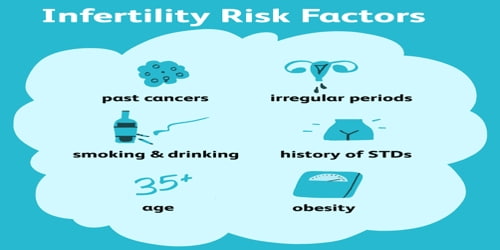Infertility (Diagnosis, Treatment, and Preventions)
Definition: In humans, infertility is the inability to become pregnant/impregnate or carry a pregnancy to full term. There are many causes of infertility, including some that medical intervention can treat. It happens when a couple cannot conceive after having regular unprotected sex. Infertility is usually not the natural state of a healthy adult, except notably among certain eusocial species (mostly haplodiploid insects).
Infertility causes can affect one or both partners. In general:
- In about one-third of cases, there is an issue with the male.
- In about one-third of cases, there is an issue with the female.
- In the remaining cases, there are issues with both the male and female or no cause can be identified.

Risk factors for infertility include:
- older age
- smoking
- history of sexually transmitted infections (STIs)
- very high or very low weight
- heavy alcohol use
Being diagnosed with infertility doesn’t mean that their dreams of having a child have come to an end. It may take some time, but a significant number of infertile couples will eventually be able to have a child. Some will do so on their own. Others will need medical assistance.
The World Health Organization defines infertility as follows:
“Infertility is “a disease of the reproductive system defined by the failure to achieve a clinical pregnancy after 12 months or more of regular unprotected sexual intercourse (and there is no other reason, such as breastfeeding or postpartum amenorrhoea). Primary infertility is infertility in a couple who have never had a child. Secondary infertility is the failure to conceive following a previous pregnancy. Infertility may be caused by an infection in the man or woman, but often there is no obvious underlying cause.”
Types of Infertility: Infertility can be primary or secondary.
Primary infertility is defined as the absence of a live birth for women who desire a child and have been in a union for at least 12 months, during which they have not used any contraceptives.
Secondary infertility is defined as the absence of a live birth for women who desire a child and have been in a union for at least 12 months since their last live birth, during which they did not use any contraceptives.
Thus the distinguishing feature is whether or not the couple has ever had a pregnancy which led to a live birth.

Diagnosis and Treatment of Infertility: Most people will visit a physician if there is no pregnancy after 12 months of trying. The doctor may ask about the couple’s sexual habits and make recommendations regarding these. Tests and trials are available, but testing does not always reveal a specific cause.
Male fertility requires that the testicles produce enough healthy sperm and that the sperm is ejaculated effectively into the woman’s vagina and travels to the egg. Tests for male infertility attempt to determine whether any of these processes are impaired.
Specific fertility tests may include (Men & Women):
- Semen analysis
- Hormone testing
- Genetic testing
- Testicular biopsy
- Imaging
- Ovulation testing
- Hysterosalpingography
- Ovarian reserve testing
Another specialty testing – In rare cases, other tests to evaluate the quality of the sperm may be performed, such as evaluating a semen specimen for DNA abnormalities.
Infertility can be treated with medicine, surgery, intrauterine insemination, or assisted reproductive technology.
Often, medication and intrauterine insemination are used at the same time. Doctors recommend specific treatments for infertility on the basis of
The factors contributing to infertility.
- The duration of infertility.
- The age of the female.
- The couple’s treatment preference after counseling about success rates, risks, and benefits of each treatment option.
Fertility tourism is the practice of traveling to another country for fertility treatments. It may be regarded as a form of medical tourism. The main reasons for fertility tourism are legal regulation of the sought procedure in the home country or lower price. In-vitro fertilization and donor insemination are major procedures involved.
Preventions of Infertility: Some types of infertility aren’t preventable. But several strategies may increase people’s chances of pregnancy.
For men & women, although most types of infertility aren’t preventable, these strategies may help:
- Avoid alcohol and street drugs
- Quit smoking
- Avoid high temperatures
- Avoid exposure to industrial or environmental toxins
- Limit medications that may impact fertility
- Exercise moderately
- Limit caffeine
- Avoid weight extremes
For couples who experience fertility problems and those who wish to have children at an older age, there are more options available than ever before.
In 1978, the first baby was born as a result of IVF. By 2014, over 5 million people had been born after being conceived through IVF.
Information Source:
















